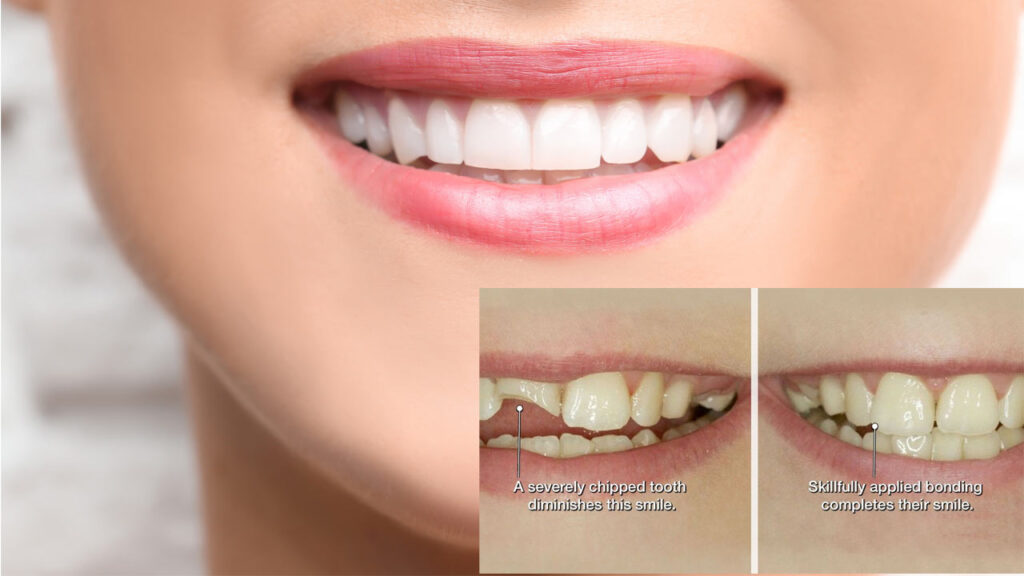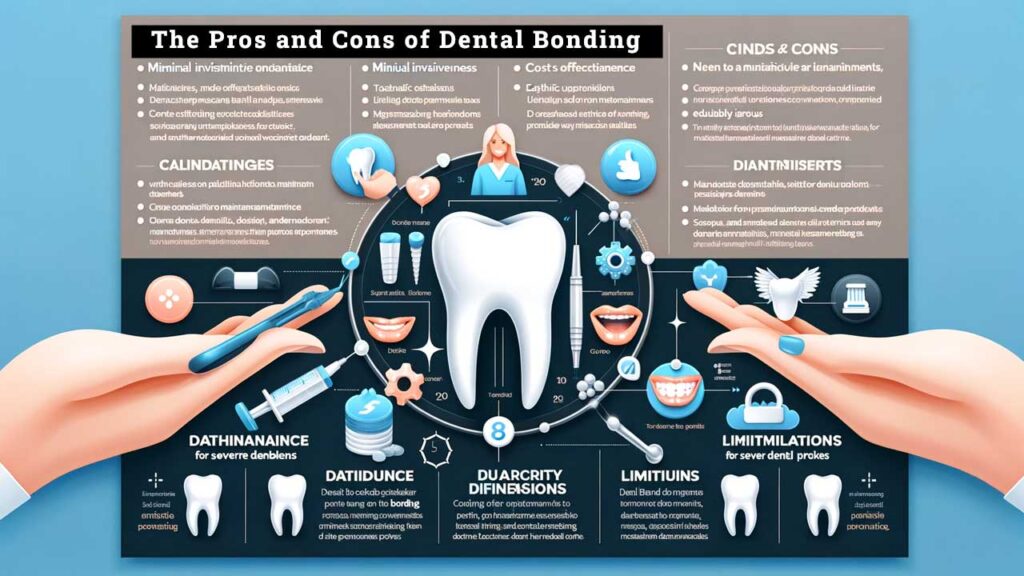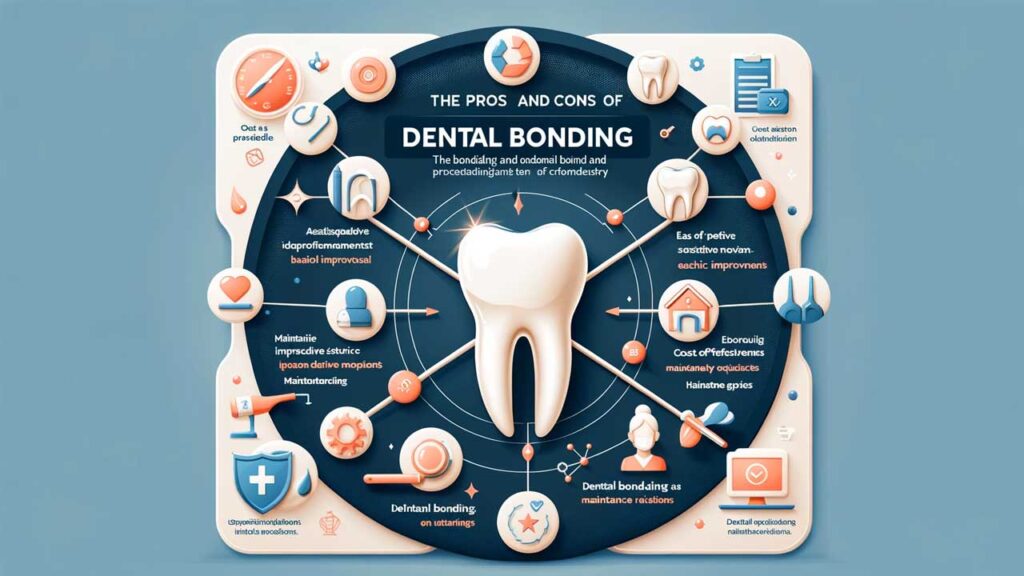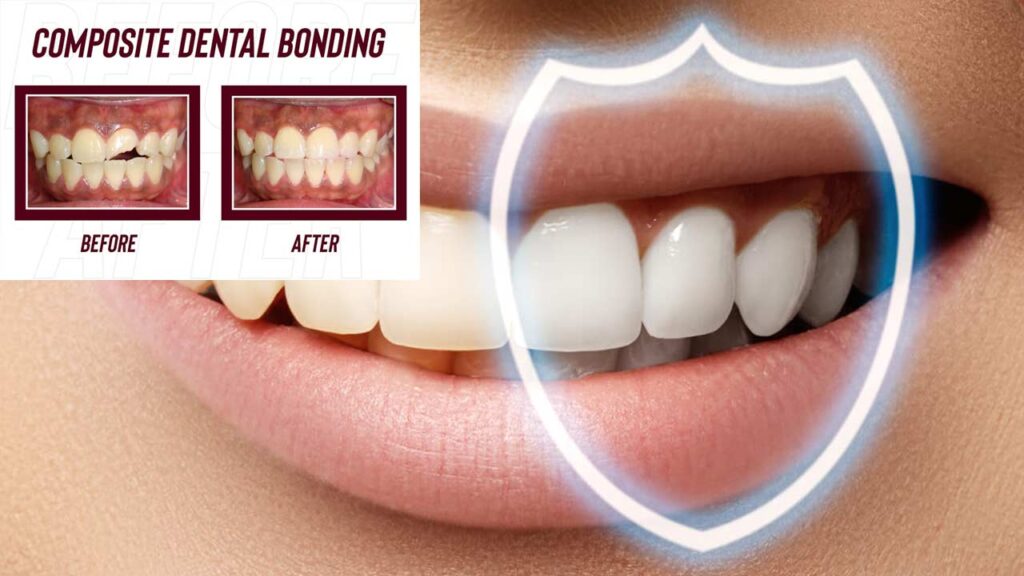Dental bonding, a popular procedure in cosmetic dentistry, offers both aesthetic and functional benefits. However, like any medical procedure, it comes with its set of advantages and disadvantages. This article delves into the pros and cons of dental bonding, providing a detailed understanding for those considering this treatment.
Importance of Understanding Dental Bonding in Cosmetic Dentistry

Understanding the implications of dental bonding is crucial for anyone looking to enhance their smile. It’s a decision that affects not just the appearance but also the health of one’s teeth. By examining both the positive and negative aspects, patients can make well-informed decisions about their dental care.
Preview and Scope of the Article
In this comprehensive guide, we will explore what dental bonding is, its key components, and why it’s considered a minimally invasive procedure. We aim to equip readers with essential knowledge and clear insights into dental bonding, helping them weigh its benefits against the potential downsides.
Understanding The Pros and Cons of Dental Bonding

Definition and Role of Dental Bonding
Dental bonding is a procedure where a tooth-colored composite resin is applied to repair and improve the appearance of a tooth. It’s commonly used for fixing chips, cracks, discoloration, or making cosmetic improvements to teeth. The process is quick, often completed in a single visit, and doesn’t require extensive tooth preparation, making it a convenient choice for many.
Dental Bonding Components and Their Functions
This table breaks down the key components used in dental bonding and their specific roles:
| Component | Function |
| Composite Resin | The primary material used, which matches the color of teeth and provides the aesthetic improvement |
| Adhesive Agents | Help in bonding the resin to the tooth structure |
| Conditioning Liquid | Prepares the tooth surface for bonding |
| Ultraviolet Light | Used to harden the resin quickly and securely |
Minimally Invasive Nature of the Procedure
One of the significant advantages of dental bonding is its minimally invasive nature. Unlike veneers or crowns, which require extensive reshaping of the natural tooth, dental bonding involves minimal alteration. The dentist applies the composite resin directly onto the tooth’s surface, shapes it, and then hardens it with ultraviolet light. This approach preserves more of the natural tooth structure and reduces the risk of damage or sensitivity post-procedure.
Evaluating the Pros of Dental Bonding
Aesthetic and Functional Benefits
Dental bonding is highly regarded for its aesthetic and functional benefits. It effectively conceals dental imperfections such as chips, cracks, and discoloration, significantly enhancing the appearance of teeth. The composite resin used in bonding can be closely matched to the natural color of teeth, ensuring a seamless and natural-looking result. Functionally, dental bonding restores the integrity of damaged teeth, improving bite and overall oral health.
Comparative Analysis of Dental Bonding vs. Other Cosmetic Procedures
This table provides a comparison between dental bonding and other common cosmetic dental procedures, highlighting their key differences and benefits.
| Procedure | Benefits | Invasiveness | Cost | Treatment Time |
| Dental Bonding | Aesthetic improvement, quick fix for minor issues | Minimally invasive | Lower cost | Single visit |
| Porcelain Veneers | Covers more severe discoloration and damage | More invasive | Higher cost | Multiple visits |
| Dental Crowns | Suitable for significant damage | Highly invasive | Higher cost | Multiple visits |
Time Efficiency and Immediate Results
Another significant advantage of dental bonding is its time efficiency. The procedure typically requires just one visit to the dentist, and the results are immediate. Unlike veneers or crowns, which require multiple visits and a more extended treatment period, dental bonding allows patients to see the transformation right away, making it an excellent option for those seeking quick cosmetic enhancements.
Assessing the Cons of Dental Bonding
Durability and Longevity Concerns
While dental bonding offers immediate aesthetic improvements, it is not as durable as other dental restoration methods like veneers or crowns. The composite resin material used in bonding can wear down or become discolored over time, especially if exposed to habits like smoking or consuming stain-causing foods and drinks. Consequently, dental bonding may require touch-ups or replacement more frequently.
Maintenance Requirements for Dental Bonding
This table outlines the maintenance requirements for dental bonding, helping patients understand the care needed to prolong the life of their bonded teeth.
| Maintenance Aspect | Frequency | Details |
| Regular Cleaning | Daily | Brushing twice a day, flossing, and using mouthwash |
| Dental Check-ups | Bi-annually | Regular visits for professional cleaning and check-up |
| Avoiding Hard Foods | Ongoing | Preventing chipping or cracking of the bonding material |
Limitations in Addressing Severe Dental Issues
Dental bonding is ideal for minor cosmetic corrections but may not be sufficient for more severe dental issues. It cannot correct significant structural damage or alignment issues, which might require more extensive treatments like orthodontics or crowns.
The Dental Bonding Procedure: Steps and Expectations

Detailed Procedure Breakdown
The dental bonding procedure involves several key steps. Initially, the dentist selects a composite resin color that matches the patient’s natural teeth. The tooth surface is then conditioned to help the bonding material adhere. After applying the resin, the dentist shapes and smooths it to achieve the desired look, finally using ultraviolet light to harden the material.
Step-by-Step Dental Bonding Process
This table provides a detailed breakdown of the dental bonding process step by step.
| Step | Description |
| Color Selection | Matching the resin to the natural tooth color |
| Surface Conditioning | Preparing the tooth for bonding |
| Application of Resin | Applying and shaping the composite resin |
| Hardening | Using ultraviolet light to solidify the resin |
| Polishing | Final adjustments for a smooth, natural appearance |
Aftercare and Recovery
Post-procedure care for dental bonding is relatively straightforward. Patients can usually resume normal activities immediately, although it’s advised to avoid stain-causing foods and beverages for the first 48 hours. Good oral hygiene practices and regular dental visits are crucial for maintaining the results of the bonding.
Dental Bonding vs. Other Treatments: A Comprehensive Comparison
Cost, Durability, and Aesthetic Differences
When comparing dental bonding with other treatments like veneers and crowns, several factors stand out. Cost-wise, dental bonding is often more affordable, making it a budget-friendly option for many patients. However, in terms of durability, veneers and crowns typically last longer than dental bonding, which might need retouching or replacement over time. Aesthetically, while all three options can significantly enhance a smile, veneers and crowns are more resistant to staining and can provide a more transformative change, especially for severe dental issues.
Suitability for Different Dental Conditions
Dental bonding is particularly suitable for minor cosmetic corrections, such as small chips or cracks, and slight discolorations. It’s a quick fix that can be done in a single visit. On the other hand, veneers and crowns are more suited for extensive dental repairs, such as major chips, significant discoloration, or when altering the tooth’s shape or size is necessary.
Pros and Cons of Dental Bonding vs. Veneers and Crowns
This table outlines the advantages and disadvantages of dental bonding compared to veneers and crowns, helping patients understand which option might be best for their specific needs.
| Treatment | Pros | Cons |
| Dental Bonding | Less expensive, minimally invasive, quick procedure | Less durable, prone to staining, suitable for minor corrections |
| Veneers | Highly durable, stain-resistant, transformative aesthetic change | More expensive, requires enamel removal, irreversible |
| Crowns | Suitable for extensive repair, very durable, covers the entire tooth | More invasive, higher cost, requires significant tooth reshaping |
Post-Procedure Care: Maximizing the Benefits
Maintenance and Oral Hygiene Best Practices
To maximize the benefits and longevity of dental bonding, proper maintenance and oral hygiene are crucial. Patients should brush their teeth twice a day using a soft-bristled toothbrush and non-abrasive toothpaste. Flossing daily and using an antiseptic mouthwash can help maintain overall oral health and prevent issues that could compromise the bonded area.
Long-Term Care and Regular Dental Check-Ups
Regular dental check-ups are essential for maintaining the health and appearance of bonded teeth. During these visits, the dentist can check the integrity of the bonding and perform professional cleanings, which are vital for preventing plaque buildup and staining.
Tips for Ensuring Longevity of Bonding
To ensure the longevity of dental bonding, patients should avoid habits that can damage the bonding material, such as biting on hard objects (like pens or ice) or using their teeth to open packaging. It’s also advisable to limit the intake of stain-causing foods and drinks and to avoid smoking.
Specific Applications of Dental Bonding
Addressing Various Dental Issues with Bonding
Dental bonding is versatile and can address a range of dental issues. It’s commonly used to repair chipped or cracked teeth, close gaps between teeth, and improve the appearance of discolored or misshapen teeth. The procedure can also be used to protect exposed tooth roots due to gum recession.
Aesthetic Enhancements and Smile Makeovers
For those looking for aesthetic enhancements, dental bonding can be a key component of a smile makeover. It can quickly improve the appearance of a tooth and is often combined with other cosmetic procedures, such as teeth whitening, for a complete smile transformation.
Customized Treatment Approaches
Each dental bonding procedure is tailored to the patient’s specific needs. The dentist carefully selects a composite resin that matches the natural color of the patient’s teeth, ensuring that the bonding blends in seamlessly with the surrounding teeth. This customization allows for a natural-looking and aesthetically pleasing result.
Patient Experiences and Testimonials
Real-Life Case Studies and Before-After Scenarios
Patient experiences play a crucial role in understanding the real-life impact of dental bonding. Case studies and before-and-after scenarios often reveal the transformative nature of this treatment. For example, a patient with a chipped front tooth can experience an immediate restoration of their smile, boosting their confidence significantly. Similarly, individuals with discolored or slightly misaligned teeth have shared positive outcomes in terms of aesthetic enhancement.
Patient Satisfaction Ratings and Feedback
To provide a clearer picture, this table summarizes patient satisfaction ratings and feedback based on various aspects of dental bonding.
| Aspect | Satisfaction Rating | Patient Feedback |
| Aesthetic Improvement | High | “My smile looks natural and beautiful.” |
| Procedure Experience | Moderate to High | “The process was quicker and less invasive than I expected.” |
| Durability and Maintenance | Moderate | “Needed a touch-up after a few years, but overall happy.” |
Weighing Expectations Against Real Outcomes
It’s important to balance patient expectations with actual outcomes. While dental bonding is praised for its immediacy and aesthetic appeal, it’s also essential to understand its limitations, particularly in terms of durability and the potential need for future maintenance.
Navigating Costs and Insurance
Understanding Insurance Coverage and Out-of-Pocket Expenses
Navigating the financial aspects of dental bonding is crucial for patients. Dental bonding, primarily considered a cosmetic procedure, may not be covered by all dental insurance plans. Patients should check with their insurance providers to understand what is covered and what out-of-pocket expenses they might incur.
Cost-Benefit Analysis of Dental Bonding
The cost-effectiveness of dental bonding becomes evident when compared with other cosmetic dental procedures. While it may not last as long as veneers or crowns, its lower initial cost makes it an attractive option for many, especially for minor cosmetic corrections.
Affordability and Accessibility Considerations
Dental bonding is often lauded for its affordability and accessibility. It’s a less expensive alternative to more extensive cosmetic dentistry, making it accessible to a broader range of patients. This affordability, coupled with the procedure’s effectiveness in enhancing dental aesthetics, makes it a popular choice in cosmetic dentistry.
FAQ About Dental Bonding
Dental bonding is a popular cosmetic dentistry procedure, but it often raises many questions. This section aims to answer some of the most frequently asked questions about dental bonding in an easy-to-understand manner.
How Long Does Dental Bonding Last on Front Teeth?
The longevity of dental bonding on front teeth varies but typically lasts from 4 to 8 years. Its lifespan can be extended with proper care, including avoiding habits like biting nails or chewing on hard objects, and maintaining good oral hygiene.
Is Dental Bonding a Good Option for Chipped Teeth?
Yes, dental bonding is an excellent option for repairing chipped teeth. It can restore the appearance and functionality of the tooth efficiently and is a less invasive alternative compared to other procedures like veneers or crowns.
Cost of Dental Bonding vs Porcelain Veneers
The cost of dental bonding is generally lower than porcelain veneers. While veneers offer a more durable solution, they are more expensive due to the materials used and the complexity of the procedure. Dental bonding provides a cost-effective solution for minor cosmetic changes.
Maintaining Oral Hygiene with Dental Bonding
Maintaining oral hygiene with dental bonding involves regular brushing and flossing, using a soft-bristled toothbrush, and avoiding abrasive toothpaste. Regular dental check-ups are also crucial for ensuring the longevity of the bonding.
Advantages of Dental Bonding Over Other Cosmetic Treatments
The primary advantages of dental bonding over other cosmetic treatments are its affordability, minimal invasiveness, and the relatively short time required for the procedure. It’s also a versatile treatment, suitable for a variety of cosmetic dental issues.
How Effective is Dental Bonding for Tooth Discoloration?
Dental bonding can be quite effective in addressing tooth discoloration, especially for localized staining. It’s an excellent option for patients looking for a quick and affordable solution to improve the appearance of discolored teeth.
Dental Bonding Procedures for Smile Enhancement
Dental bonding can significantly enhance a smile by correcting chips, gaps, and stains. It’s often used as part of a comprehensive smile makeover due to its ability to improve dental aesthetics quickly and non-invasively.
Post Dental Bonding Care Tips
Post dental bonding care includes avoiding staining foods and drinks for the first 48 hours, not biting hard objects, and maintaining regular dental hygiene. It’s also advisable to avoid smoking and excessive alcohol consumption to prevent staining.
Can Dental Bonding Improve My Smile Aesthetically?
Yes, dental bonding can dramatically improve a smile aesthetically. It can reshape teeth, fill gaps, and correct discoloration, contributing to a more uniform and appealing smile.
Comparing Durability of Dental Bonding and Crowns
While dental bonding is effective for cosmetic purposes, it is less durable than crowns. Crowns encompass the entire tooth, providing more strength and protection, making them a better option for severely damaged teeth.
Affordable Cosmetic Dentistry Options: Is Dental Bonding Right for You?
Dental bonding is one of the most affordable cosmetic dentistry options. It’s ideal for those seeking minor cosmetic improvements without the high cost of more extensive procedures.
What to Expect During a Dental Bonding Treatment?
During a dental bonding treatment, patients can expect the dentist to select a composite resin that matches their tooth color, apply it to the affected area, mold it to the desired shape, and then harden it with a special light. The process is typically painless and completed within one visit.
Reflecting on “The Pros and Cons of Dental Bonding,” it’s clear that this cosmetic procedure offers a blend of benefits and limitations. The pros, such as cost-effectiveness, aesthetic enhancement, and minimally invasive nature, make it an attractive choice for those seeking quick improvements in their smile. On the flip side, concerns about durability, limitations in treating extensive dental issues, and maintenance requirements underscore the need for careful consideration.
Making an informed decision about undergoing dental bonding requires a comprehensive analysis of these pros and cons. It’s essential for individuals to weigh the immediate aesthetic benefits against the long-term considerations of maintenance and durability.
In the evolving field of cosmetic dentistry, dental bonding remains a significant and viable option for many. While it may not be the universal solution for all dental issues, its role in providing accessible and quick cosmetic enhancements is undeniable. Prospective patients are encouraged to discuss their specific needs with a dental professional to determine if dental bonding is the right choice for their unique dental journey.

